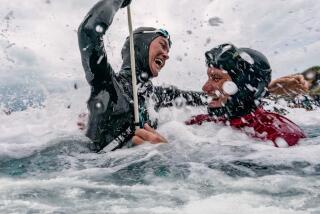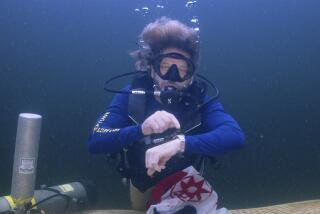Jim Stewart, Scripps diver who opened the sea to scientists, dies at 89
- Share via
Jim Stewart, an innovative Scripps Institution of Oceanography diver-educator who helped open the world’s oceans to scientists in the 1950s and ’60s by training them to use some of the first scuba equipment, has died. He was 89.
Stewart died from natural causes Wednesday in Irvine, according to Scripps.
During a career that lasted five decades, Stewart helped design and carry out some of the most rigorous training ever done for scuba gear, which revolutionized science and military diving after it was introduced in the United States in the late 1940s.
Jacques Cousteau and Émile Gagnan created the so-called aqualung underwater breathing device to enable divers to roam the depths without being tethered to air hoses attached to boats. The device was a godsend to Stewart, who had spent much of his childhood free-diving and spear fishing in the marine wonderland that is La Jolla Cove.
He would later spend 30 years as the dive officer at Scripps, where he trained thousands of divers and did pioneering underwater exploration in the Channel Islands and the submarine canyon off the Scripps Pier. He also descended 600 feet in a saturation bell.
In 1962, Stewart helped rescue famed Swiss deep diver Hannes Keller, who got into trouble after descending 1,000 feet in a diving bell off Santa Catalina Island.
Historians also note that Stewart explored an underwater crater in the Pacific only days after it was hit by a hydrogen bomb, and he helped standardize the protocol for safe dives in the Antarctic.
“Among scientific and technical divers, Jim Stewart enjoys the status that Chuck Yeager has among professional pilots,” San Diego dive historian Eric Hanauer wrote in a 1999 book about diving pioneers. “… he organized it, standardized it and spread that knowledge around the country and around the world. In the process, he made a lot of history and had a lot of fun.”
Hanauer repeated that sentiment Thursday, adding: “Jim was a diver’s diver.”
Stewart also was praised by Paul Dayton, a veteran Scripps researcher. Dayton said that instead of projecting a macho attitude, Stewart “respected scientists and the fact that young student scientists were not the reincarnation of Navy divers, but very smart students who may have just been ‘OK’ in the water.
“Jim’s goal was not to make scientists out of macho divers but to make safe divers of good scientists.”
Cary Humphries, a dive boat captain in San Diego, said, “Jim was always willing to lend a hand, no matter the situation. On research trips, he’d be the senior diver. But he didn’t want to be waited on. He’d go into the galley and wash dishes. He always wanted to help.”
James Ronald Stewart was born Sept. 5, 1927, in National City and fell in love with the ocean early. In a 2000 interview. Stewart keenly remembered fishing with his father from the Scripps Pier.
“When he’d catch a fish, I would take a look at it and run up to the old Scripps aquarium and see what that fish was,” Stewart recalled. “Little did I think I would spend 50 years of my life here.”
A turning point occurred on Memorial Day, 1941, when he took a date to La Jolla Cove. They ran into one of Stewart’s junior high school friends, who claimed to have a face mask for looking into the sea.
“I put his mask on, and I could see underwater,” he recalled. “Well, the next week I had me a face mask, and that’s how it all started.”
He became an accomplished spear fisherman and was later invited to join the elite San Diego Bottom Scratchers free-diving club, which deepened his passion for the ocean.
Stewart learned the fundamentals of scuba diving in 1951 and became a volunteer at Scripps the following year, where he worked with pioneering divers Connie Limbaugh and Andy Rechnitzer.
He was soon helping with diver training, and he expanded into research, exploring kelp beds, whose long, luminous blades formed small “amber forests” off the California coast.
In the mid-1950s, Stewart helped explore and evaluate Pacific atolls that had been the site of hydrogen bomb tests. He joined Scripps full time in 1957, and was with Limbaugh and researcher Wheeler North in 1959 when the trio discovered underwater sandfalls off Cabo San Lucas. The discovery was the subject of the award-winning documentary, “Rivers of Sand.”
Tragedy struck a year later, in 1960, when Limbaugh died in a cave-diving accident. Stewart succeeded him as Scripps’ dive officer.
The following year, Stewart was attacked by a shark off Wake Island. A colleague got him to shore, and flagged down a dump truck, which took Stewart to a hospital.
The attack was an odd counterpoint to the work Stewart had done testing shark repellents.
Stewart has also experienced good fortune, notably in 1967, when he was among the first divers in Truk Lagoon in the Pacific.
“We went in there because we had the tail end of a typhoon and we needed a place to hide,” Stewart told interviewer Ron Rainger. “So we ran in there, and just happened to anchor in the old Japanese harbor, masts sticking out. We went out and looked at that, and there were all kinds of artifacts on the bottom. That was fun.”
Two years later, he was making his first dives beneath the ice in Antarctica, an experience he compared to floating above the Grand Canyon during a 1991 interview with the San Diego Tribune.
Stewart said, “It’s almost like you’re going to fall; the water is very, very clear. You don’t really have a concept of being in water.”
Stewart continued to dive for decades, experiencing great adventure, which he loved to talk about.
“Sit down with him over a beer, and you will be treated to diving history, told vividly by someone who made it and lived it,” Hanauer said of Stewart in his book, “Diving Pioneers.”
“But his greatest legacy is his students, and the students of those he has trained. No one else has influenced more diving leaders, directly and indirectly, both in the world of scientific and sport diving.”
Stewart is survived by wife of 64 years, Joan; his son Craig; his daughter Meredith; and four grandchildren.
gary.robbins@sduniontribune.com
Robbins writes for the San Diego Union-Tribune.
More to Read
Start your day right
Sign up for Essential California for the L.A. Times biggest news, features and recommendations in your inbox six days a week.
You may occasionally receive promotional content from the Los Angeles Times.







